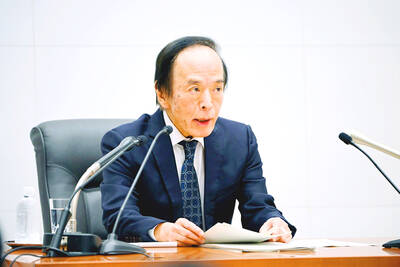The Okura Prestige Taipei (大倉九和), the newest addition to the Tokyo-based international luxury hotel group Okura Hotels & Resorts, yesterday celebrated its official entry into the Taiwanese market.
With 18 stories above ground and seven underground and 208 guestrooms with Asian and Western decor and modern amenities, the hotel hopes to take advantage of Taiwan’s thriving tourism market. It is located in Taipei’s bustling Zhongshan District (中山), a place closely connected to Japan’s presence in Taiwan.
VITAL MARKET
The hotel group is rapidly expanding overseas and Taiwan is an important market for the group, given the rapid increase in Japanese tourists, Japanese general manager Shinji Umehara said.
Bilateral travel between Taiwan and Japan is expected to reach 3 million trips this year, jumping 23 percent from last year, Umehara said, adding that figures from last year rose 20 percent from a year earlier.
Japan is the second-largest source of foreign tourists to Taiwan after China, with the number of visitors gradually recovering to the levels before the earthquake on March 11 last year, he said.
The aviation agreement between the two countries last year to lift restrictions on the number of carriers allowed to offer scheduled passenger services will make bilateral business and tourist travel easier and more frequent, Umehara said.
Umehara expects the occupancy rate at the Okura Prestige Taipei to reach 65 percent to 70 percent, with room rates averaging NT$5,500 and NT$6,000.
He expects Japanese travelers to account for 70 percent of the clientele, while European, Taiwanese and guests from other Asian countries are expected to account for another 10 percent each.
Food and beverages are expected to generate 40 percent of the hotel’s revenue and hotel rooms another 60 percent, he said.
The hotel offers three dining options, including Okura’s signature Japanese restaurant “Yamazato” and Cantonese restaurant “Toh-Ka-Lin.” The hotel also features two full bars — one in the lobby and the other next to the rooftop swimming pool.
BENEFICIAL
The Ambassador Hotel (國賓大飯店) and the Regent Taipei (晶華) welcomed the new entrant, saying competition is beneficial to the industry.
Ambassador vice president and head of financial department Bill Chen (陳榮輝) said the presence of Okura Prestige might attract more visitors to Taiwan and lift the sector’s overall room rates, as the entry of W Hotel did last year.
The Regent Taipei voiced similar views, saying the hotel also benefited from increased competition in recent years.

Taiwan’s long-term economic competitiveness will hinge not only on national champions like Taiwan Semiconductor Manufacturing Co. (TSMC, 台積電) but also on the widespread adoption of artificial intelligence (AI) and other emerging technologies, a US-based scholar has said. At a lecture in Taipei on Tuesday, Jeffrey Ding, assistant professor of political science at the George Washington University and author of "Technology and the Rise of Great Powers," argued that historical experience shows that general-purpose technologies (GPTs) — such as electricity, computers and now AI — shape long-term economic advantages through their diffusion across the broader economy. "What really matters is not who pioneers

In a high-security Shenzhen laboratory, Chinese scientists have built what Washington has spent years trying to prevent: a prototype of a machine capable of producing the cutting-edge semiconductor chips that power artificial intelligence (AI), smartphones and weapons central to Western military dominance, Reuters has learned. Completed early this year and undergoing testing, the prototype fills nearly an entire factory floor. It was built by a team of former engineers from Dutch semiconductor giant ASML who reverse-engineered the company’s extreme ultraviolet lithography (EUV) machines, according to two people with knowledge of the project. EUV machines sit at the heart of a technological Cold

TAIWAN VALUE CHAIN: Foxtron is to fully own Luxgen following the transaction and it plans to launch a new electric model, the Foxtron Bria, in Taiwan next year Yulon Motor Co (裕隆汽車) yesterday said that its board of directors approved the disposal of its electric vehicle (EV) unit, Luxgen Motor Co (納智捷汽車), to Foxtron Vehicle Technologies Co (鴻華先進) for NT$787.6 million (US$24.98 million). Foxtron, a half-half joint venture between Yulon affiliate Hua-Chuang Automobile Information Technical Center Co (華創車電) and Hon Hai Precision Industry Co (鴻海精密), expects to wrap up the deal in the first quarter of next year. Foxtron would fully own Luxgen following the transaction, including five car distributing companies, outlets and all employees. The deal is subject to the approval of the Fair Trade Commission, Foxtron said. “Foxtron will be

INFLATION CONSIDERATION: The BOJ governor said that it would ‘keep making appropriate decisions’ and would adjust depending on the economy and prices The Bank of Japan (BOJ) yesterday raised its benchmark interest rate to the highest in 30 years and said more increases are in the pipeline if conditions allow, in a sign of growing conviction that it can attain the stable inflation target it has pursued for more than a decade. Bank of Japan Governor Kazuo Ueda’s policy board increased the rate by 0.2 percentage points to 0.75 percent, in a unanimous decision, the bank said in a statement. The central bank cited the rising likelihood of its economic outlook being realized. The rate change was expected by all 50 economists surveyed by Bloomberg. The